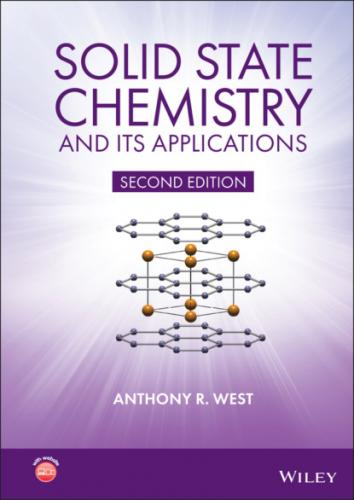For the examples shown in Fig. 1.41(j) and (k), rotation of octahedra about only one axis is shown and therefore the two possibilities are labelled a 0 a 0 c – and a 0 a 0 c +. These are easy to appreciate since the rotations are about one axis only. For cases involving rotation about all three axes, detailed scrutiny of the structures may be needed; thus for GdFeO3, the tilt system is a – b + a – although this may not be readily apparent from diagram (g). The different tilt systems give rise to structures with unit cells that are usually no longer cubic. For instance, GdFeO3 has a larger orthorhombic unit cell with
An interesting tilt system which retains cubic symmetry is a + a + a + and is shown by a family of phases with general formula A′A″3B4O12 with CaCu3Ti4O12 as the most studied example. The TiO6 octahedra undergo similar coupled rotations about all three axes; a consequence of this is that three‐quarters of the A sites change their coordination from 12‐coordinate to square planar. This structure is shown by a number of compounds in which Cu, Mn and Ni occupy the square planar A″ sites, Fig. 1.42(a) discussed next.
1.17.7.4 CaCu3Ti4O12, CCTO
There is much recent interest in a family of perovskite‐related phases typified by CaCu3Ti4O12 because of the possibility that they exhibit a giant dielectric constant. It is now known that the measured high permittivities are not a property of the bulk crystals but are associated with the grain–grain contacts in ceramics. The high permittivity is a consequence of the geometry of the regions responsible since the capacitance of a region is proportional to its area but inversely proportional to its thickness. CCTO has a most unusual crystal structure since the A sites of perovskite contain intermediate‐size Ca cations whose coordination number is reduced to eight by tilting of TiO6 octahedra together with square planar CuO4 units. The crystal structure is shown in Fig. 1.42(a) in which the left‐hand diagram emphasises tilting of the TiO6 octahedra and the right‐hand diagram shows the square planar Cu‐based units which have three equivalent orientations in the cubic unit cell. In Glazer notation, the tilt system for CCTO is a + a + a + .
Figure 1.42 (a) Crystal structure of CaCu3Ti4O12.
Modified from E. S. Bozin et al., J. Phys. Condens. Matter 16, S5091 (2004).
(b) The brownmillerite structure.
Modified from G. J. Redhammer et al., Amer. Miner. 89, 405 (2004).
(c) The La2Ni2O5 structure.
Modified from J. A. Alonso et al., J. Phys. Cond. Matter 9, 6417 (1997).
(d, e) A 2D section through the perovskite structure showing corner‐linked BO6 octahedra in which different cations B, B′ may be either (d) disordered or (e) ordered: A‐site cations are omitted for clarity; (f) structure‐field map showing the effect of A and B sizes on structure type; (g) crystal structure of BaNiO3 as an [001] projection with some NiO6 octahedra emphasised: space group P63/mmc; a = 5.629, c = 4.811 Å; atomic positions Ba (2d) 1/3, 2/3, 3/4; 2/3, 1/3, 1/4; Ni (2a) 0, 0, 0; 0, 0, 1/2; O 6( h) x, 2x, 1/4: x = 0.1462; (h) one column of face‐sharing octahedra parallel to c. O and Ba positions together form BaO3 layers; (i–l) different polytypes and labelling notations. For each, h and c layers and the number of layers in the unit cell are shown: (i) (ch)2 BaRuO3, (j) (cch)2 BaTiO3, (k) (cchc)2 Ba8Ta4Ti3O24, (l) (cchcc)2 Ba10Ta7.04Ti1.2O30.
A wide range of compositions, AA′3B4O12 form the same structure as CCTO. A is an intermediate‐sized alkali, alkaline earth or rare earth cation such as Na+, Ca2+, La3+, Pr3+, Nd3+ or a lone pair p‐block cation Pb2+, Bi3+ that occupies the 8‐coordinate sites; A′ is either of the Jahn‐Teller active ions Cu2+ or Mn3+ that occupies the square planar sites; B is a transition metal such as Ti, V, Mn, Fe, Co, Rh, Ir, or a p‐block element Ga, Ge, Sn, Sb that occupies the octahedral sites. The structures are cubic with a = 2a p, where a p is the lattice parameter of the perovskite subcell.
The electrical and magnetic properties of these materials depend on the valence states of the transition metal cations that occupy A′ and B sites. These may change if charge disproportionation phenomena occur, such as disproportionation at low temperatures of Fe4+ into Fe3+ and Fe5+ in the Fe analogue of CCTO or if temperature‐dependent local electron transfer or redox reaction occurs between cations such as Cu2++/Fe4+ and Cu3+/Fe3+ in LaCu3Fe4O12. Novel phenomena and properties may be anticipated following in‐depth studies of structure–property correlations in such materials.
1.17.7.5 Anion‐deficient perovskites
Anion‐deficient perovskites occur commonly and, in cases where the anions are ordered, a variety of more complex structures are generated. As a consequence of anion deficiency, the B site coordination number must reduce from six on average. In the brownmillerite structure, Ca(Fe,Al)O2.5, Fig. 1.42(b), the average B site coordination number is expected to be five and this is achieved in a layered structure with alternating sheets of tetrahedra and octahedra. In LaNiO2.5, Fig. 1.42(c), the Ni coordination is a mixture of NiO6 octahedra and NiO4 square planes which are ordered to give a 2 × 2 × 2 supercell relative to the perovskite subcell. In the a and b directions, octahedra and square planes alternate but in the c direction chains of corner‐sharing octahedra form which are connected to adjacent chains by the square planar units. The Ni polyhedra exhibit antiphase tilting along the three unit cell axes and therefore, may be described in Glazer notation as a – a – c – . This material was produced from LaNiO3 by hydrogen reduction, but a residual amount of oxygen remained in the O(4) sites, giving a composition, for the particular material that was studied, of LaNiO2.56(1); possibly, using different preparative conditions, materials with different
